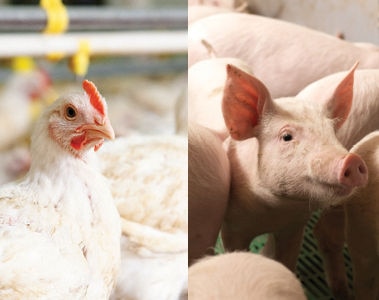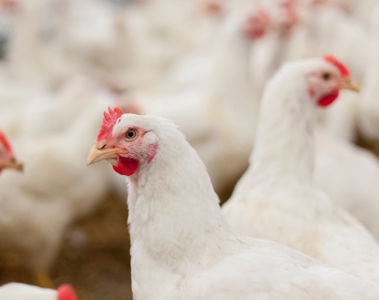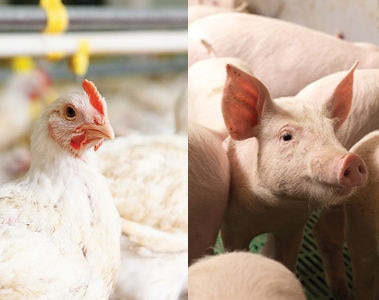Bacterial Chondronecrosis with Osteomyelitis (BCO) is a significant cause of lameness in broiler chickens, leading to substantial economic losses and animal welfare concerns in the poultry industry. BCO lameness occurs when bacterial infections infiltrate the growth plates of bones, leading to the destruction of cartilage and bone tissue. The rapid growth rate of broilers exacerbates the problem as the birds' skeletal systems struggle to support their increasing body weight (Wideman, 2016). While Enterococcus cecorum has frequently been identified in BCO lesions, attributing the disease solely to this bacterium is an oversimplification. A variety of bacterial species have been isolated from BCO lesions, indicating that BCO pathogenesis is more complex and multifactorial than previously thought (Jiang et al., 2015).
What is BCO Lameness?
BCO lameness is a debilitating condition that affects the leg bones of broiler chickens. The condition is characterized by abscess formation and necrotic tissue in bones, particularly the femora, tibiae, and 4th thoracic vertebra, which are prone to lesions due to rapid growth and repeated mechanical stress (Wideman, 2016). These lesions weaken the structural integrity of the bones, causing pain and lameness in the affected birds. The economic impact of BCO lameness is profound, as it leads to decreased weight gain, increased mortality, and the culling of affected birds, ultimately reducing the profitability of broiler production (Wideman Jr, 2017).
Signs and Symptoms of BCO
The clinical signs of BCO lameness are primarily related to the mobility and posture of the birds. Affected chickens exhibit difficulty in walking, often assuming a sitting posture for extended periods. This sitting behavior is indicative of pain or discomfort in the legs, which may result in the compression of major arteries, further compromising blood flow to the affected areas. In cases where the 4th thoracic vertebra is involved, the abscess may cause spinal cord compression and a paraplegic hock-resting posture often called the "Harley rider" position, as the bird's posture resembles that of a motorcycle rider (Wideman 2016). As the condition progresses, the birds may become completely immobile, leading to increased mortality due to starvation or trampling by other birds. In addition to lameness, BCO may be accompanied by swelling and heat in the joints, as well as a reluctance to move when urged to (Wideman Jr, 2017; Wideman, 2016).
Pathogenesis of BCO
The pathogenesis of BCO is complex and involves multiple factors, including mechanical stress, bacterial colonization, and the bird's immune response. Rapid growth in broilers leads to excessive mechanical stress on the growth plates of the leg bones, creating microfractures and osteochondrotic clefts. These clefts serve as entry points for bacteria, which are typically introduced into the bloodstream from the gastrointestinal tract, respiratory system, or through wounds in the integument. Once in the bloodstream, these bacteria can colonize the growth plates, where they evade the immune system and proliferate, leading to the formation of abscesses and necrotic tissue (Wideman Jr, 2017).
Enterococcus cecorum and BCO: A Misconception?
Enterococcus cecorum has often been implicated as the primary causative agent of BCO lameness, largely due to its frequent isolation from BCO lesions. However, recent studies suggest that this association may be an oversimplification. While E. cecorum is indeed commonly found in BCO-affected birds, it is not the sole bacterium involved. Other bacterial species, including Escherichia coli and Staphylococcus sp., have also been isolated from BCO lesions, indicating that multiple pathogens can contribute to the development of the disease (Ekesi et al., 2021).
The misconception that E. cecorum is the sole causative agent of BCO lameness may stem from its high prevalence in affected birds. However, the presence of other bacteria in BCO lesions suggests that BCO is a multifactorial disease, with various bacteria playing roles at different stages of pathogenesis. For instance, some strains of E. cecorum have been shown to carry virulence factors that enable them to colonize and cause disease in the bones, while other strains may be less virulent or even commensal. Perhaps it is a matter of opportunity, where the pathogen causing the lesion was simply the first bone-loving bacteria to find the microfracture (Jiang et al., 2015).
Bacteria Commonly Associated with BCO
In addition to E. cecorum, several other bacterial species have been associated with BCO lameness (Ekesi et al., 2021). Notably, Escherichia coli and Staphylococcus sp. have been isolated from BCO lesions on multiple scenarios, indicating their potential role in the disease's pathogenesis.
Escherichia coli: E. coli is a highly adaptable bacterium that can cause a range of infections in poultry, including BCO. Studies have shown that different strains of E. coli can be isolated from BCO lesions on different farms, with significant genomic variation observed between strains. This suggests that E. coli may evolve or adapt to specific farm environments, potentially leading to outbreaks of BCO. The diversity of E. coli strains involved in BCO also highlights the importance of biosecurity and management practices in controlling the spread of this bacterium (Wideman Jr, 2017).
Staphylococcus sp: Staphylococcus sp. are frequently isolated from BCO lesions. Research indicates that certain clades of S. aureus have become highly specialized for infecting chickens, with some strains having been restricted to poultry for decades. These strains have acquired additional virulence factors over time, making them particularly effective at causing BCO. For example, specific pathogenicity islands in the S. aureus genome have been linked to the bacterium's ability to cause osteomyelitis in chickens, further implicating it as a key player in BCO pathogenesis (Ekesi et al., 2021; Wideman Jr, 2017).
Staphylococcus agnetis: S. agnetis is another bacterium that has been shown to be associated with BCO lesions. Al-Rubaye et al. (2015) reported that S. agenitis found in contaminated drinking water resulted in increased BCO incidence when using their wire-floor model to induce lameness. Through metagenomic analysis, it was determined that the genome of S. agnetis contains distinct differences when compared to other Staphylococci, particularly in terms of its virulence factors (Al-Rubaye et al., 2015).
The Complexity of BCO Pathogenesis
The diversity of bacteria associated with BCO lameness underscores the complexity of the disease's pathogenesis. Rather than being caused by a single pathogen, BCO appears to result from the interaction of multiple factors, including the presence of bacteria that produce virulence factors allowing them to invade osseous tissue, mechanical stress on the bones due to increased weight and torque, and the bird's immune response (Jiang et al., 2015).
Moreover, the fact that BCO can be triggered by mechanical stress alone, without the need for bacterial inoculation, indicates that the condition is not solely dependent on the presence of pathogenic bacteria. Instead, BCO may arise when mechanical stress creates favorable conditions for bacterial colonization, such as the formation of osteochondrotic clefts. Once these clefts are colonized by bacteria, the disease progresses as the bacteria evade the immune system and proliferate within the bone tissue (Wideman Jr, 2017).
Conclusion
BCO lameness is a complex and multifactorial disease that significantly impacts the poultry industry. While Enterococcus cecorum has often been implicated as the primary causative agent, it is clear that BCO is not solely attributable to this bacterium. Other bacterial species, including Escherichia coli and Staphylococcus sp., have been isolated from BCO lesions, indicating that multiple pathogens can contribute to the disease. Understanding the diversity of bacteria involved in BCO pathogenesis is crucial for developing effective prevention and control strategies. By looking beyond E. cecorum and considering the broader microbial communities associated with BCO, researchers and poultry producers can gain a more comprehensive understanding of the disease and work towards mitigating its impact on broiler production.
References
Al-Rubaye A. A. K., Couger M. B., Ojha S., Pummill J. F., Koon J. A., Wideman R. F. (2015) Genome Analysis of Staphylococcus agnetis, an Agent of Lameness in Broiler Chickens. PLoS ONE 10(11), e0143336. doi:10.1371/journal.pone.0143336
Ekesi, N. S., Dolka, B., Alrubaye, A. A. K., & Rhoads, D. D. (2021). Analysis of genomes of bacterial isolates from lameness outbreaks in broilers. Poultry Science, 100(7), 101148. https://doi.org/10.1016/j.psj.2021.101148
Jiang, T., Mandal, R. K., Wideman, R. F., Khatiwara, A., Pevzner, I., & Min Kwon, Y. (2015). Molecular Survey of Bacterial Communities Associated with Bacterial Chondronecrosis with Osteomyelitis (BCO) in Broilers. PLOS ONE, 10(4), e0124403. https://doi.org/10.1371/journal.pone.0124403
Wideman Jr, R. F. (2017). Leg disorders in poultry: Bacterial chondronecrosis with osteomyelitis (BCO). https://www.taylorfrancis.com/chapters/edit/10.4324/9781351114325-23/leg-disorders-poultry-bacterial-chondronecrosis-osteomyelitis-bco-robert-wideman-jr-university-arkansas-usa
Wideman, R. F. (2016). Bacterial chondronecrosis with osteomyelitis and lameness in broilers: A review. Poultry Science, 95(2), 325–344. https://doi.org/10.3382/ps/pev320



